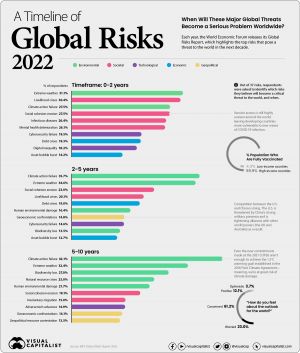Ecological Crisis Timeline: Difference between revisions
No edit summary |
No edit summary |
||
| Line 1: | Line 1: | ||
[[File:Timeline of global risk.jpg|alt=Timeline of global risk|thumb|Timeline of global risk]] | [[File:Timeline of global risk.jpg|alt=Timeline of global risk|thumb|Timeline of global risk]] | ||
P (population) x S (services used by people) x E (energy needed to power those services) x C = CO2 (carbon dioxide output) | P (population) x S (services used by people) x E (energy needed to power those services) x C = CO2 (carbon dioxide output) | ||
Revision as of 23:20, 4 April 2022
P (population) x S (services used by people) x E (energy needed to power those services) x C = CO2 (carbon dioxide output)
Population is trending ever-higher, as are the services people demand, especially in the developing world which has barely scratched the surface in terms of cars and air conditioning and other modern basics.
Every part per million (ppm) we go past 400ppm of CO2 in the atmosphere increases our chance of a disaster happening. Whilst the everyday chances of something happening is remote, everyday by doing nothing we are purchasing an accumulative lottery ticket for doomsday. The most likely occurrence would be if we remove the foundations of Maslow's hierarchy of human needs lack of water and food which causes mass migration would be the most likely tipping point. “Only a crisis – actual or perceived – produces real change. When that crisis occurs, the actions that are taken depend on the ideas that are lying around.”
